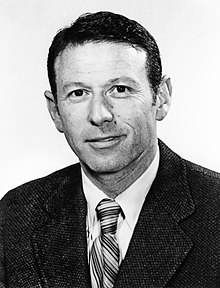Paul Berg
Paul Berg (born June 30, 1926 in Brooklyn , New York City ) is an American biochemist and molecular biologist . In 1980 he was awarded the Nobel Prize in Chemistry for his contributions to the biochemistry of nucleic acids and the development of recombinant DNA methods.
Life
Paul Berg was born in New York in 1926 and studied at Pennsylvania State University until 1948 . In 1952 he received his doctorate from Case Western Reserve University in Ohio . He was offered a professorship in biochemistry at Stanford University in California in 1959.
plant
While Frederick Sanger and Walter Gilbert were jointly awarded the Nobel Prize for their work on the sequencing of DNA, Berg mainly dealt with the methods of recombinant DNA technology. From 1965 he became interested in Roberto Dulbecco's research on the polioma virus. During a "sabbatical year" in Dulbecco's laboratory in 1967/68 he developed the idea that virus-mediated tumor development was linked to the integration of the virus genome into the host cell genome and the subsequent expression of viral genes in the host cell. In the next few years he made the decision to use SV40 as a model organism for tumor research and for the development of what would later become known as recombinant DNA techniques. In 1972 he published the results of an experiment in which a so-called “hybrid genome” was generated from the virus chromosome and plasmid DNA in his laboratory. The plasmid contained parts of the DNA of the bacteriophage lambda and three E-Coli genes that are responsible for the bacterial utilization of galactose. In 1979 he published the results of a successful attempt to use SV40 to express the β-globin gene from rabbits in monkey kidney cells.
Despite his personal successes and advances in DNA research, Paul Berg warned of the risks of this technology and was primarily responsible for the international moratorium on genetic engineering that was passed at the Asilomar Conference on Recombinant DNA in 1975 , which over several years focused on researching specific, particularly delicate experiments through voluntary renunciation.
Awards (selection)
- 1959: Eli Lilly Award in Biological Chemistry
- 1966: Member of the American Academy of Arts and Sciences
- 1966: Member of the National Academy of Sciences
- 1966: Fellow of the American Association for the Advancement of Science
- 1980: Albert Lasker Award for Basic Medical Research
- 1980: Gairdner Foundation International Award
- 1980: Nobel Prize in Chemistry
- 1981: Member of the Académie des Sciences
- 1983: National Medal of Science for Biology
- 1983: Member of the American Philosophical Society
- 1999: Max Delbrück Medal
- 2005: Biotechnology Heritage Award
Web links
- Information from the Nobel Foundation on the awarding of the 1980 award to Paul Berg (English)
- Literature by and about Paul Berg in the catalog of the German National Library
Individual evidence
- ^ Dissections and Reconstructions of Genes and Chromosomes. Paul Berg, Nobel Lecture 1980.
- ^ P. Berg, JE Mertz: Personal reflections on the origins and emergence of recombinant DNA technology. In: Genetics. 184 (1), Jan 2010, pp. 9-17. PMID 20061565 .
- ↑ David A. Jackson, Robert H. Symons, Paul Berg: Biochemical Method for Inserting New Genetic Information into DNA of Simian Virus 40: Circular SV40 DNA Molecules Containing Lambda Phage Genes and the Galactose Operon of Escherichia coli. In: Proc Natl Acad Sci US A. 69 (10), Oct 1972, pp. 2904-2909. PMID 4342968 .
- ↑ RC Mulligan, BH Howard, P. Berg: Synthesis of rabbit beta-globin in cultured monkey kidney cells following infection with a SV40 beta-globin recombinant genome. In: Nature. 277 (5692), Jan 11, 1979, pp. 108-114. PMID 215915 .
- ↑ Summary Statement of the Asilomar Conference
| personal data | |
|---|---|
| SURNAME | Berg, Paul |
| BRIEF DESCRIPTION | American biochemist and molecular biologist and winner of the Nobel Prize in Chemistry (1980) |
| DATE OF BIRTH | June 30, 1926 |
| PLACE OF BIRTH | new York |
